|
This weekend I finally did what I’ve been wanting to try for over a year. I made soap! Not in a class. Not at a farm. In my own home with Mr. Fix-It at my side. It was awesome!! I now have 36 bars of soap that smell divinely of peppermint, rosemary and real sage. I seem to be that kind of person who has to have the lightbulb go off (In the words of Mork from Ork, “The time is right. The Gestault is now!”) before I can do anything new. There is something in me that is afraid to dive into the unknown unless I have all my ducks in a row. (I didn’t mix those two metaphors too badly. Ducks dive. OK?) I have to be ready, no matter how long it takes. Well, it took me a year to make soap and in that year, I watched videos, read books and still required actually seeing it done right in front of me to give me the courage to take a stab at it, myself. Just as an aside, my attempt at learning to drive in high school comes to mind as an example of my light bulb theory. My dad had bought a brand new 1965 Beetle bug – known to all you young’ns as a small, round, Volkswagen car. It was a soft green with black, rubber interior that never lost that rubber smell. It was a 4 speed manual in the floor and only knew ‘roll backwards’ when paused at a red light on a hill. My dad worked and worked with me, attempting to run me through the gear changes without eliciting a painful grinding that was a combination of the car’s innards and my father’s teeth. Every outing erupted into my father yelling in abject terror and me crying buckets of tears at my obvious stupidity concerning vehicles. I hated that car and I hated the lessons. Finally, I refused to ever learn to drive the monster. A few months later, I was sitting in my room, doing homework, while my parents had gone doing what parents determine to do in town. As I sat at my desk, I put my hand down beside me and made an ‘H’ – Forward: First gear, Backward: Second gear, To the right and forward: Third gear, now backward: Fourth gear. Press down and back: reverse. I tried it again in the air beside me. Hmmmm. I trotted downstairs to the key holder beside the garage door and grabbed the keys to the Beetle. Inside the car, I put my foot on the clutch and practiced first, second, third, fourth, reverse. First, second, third, fourth, reverse. I opened the garage door and started the car. I backed that car out as pretty as you please and tootled all over the subdivision without a hitch!! And then, I put the car back into the garage, went back upstairs and continued to study. My parents never did know what happened. I just started driving the car and drove it for years. I loved that car! So now, I’m hooked on soap making. It is just fun. Addictive is more like it. I took pictures and thought I would do this in two posts. This first is on how to render the tallow that is used in many soap recipes. There are also recipes that use other oils instead, but I wanted to make a nice, firm Castille soap with a tallow base because of its quality and longevity of use. I get fat from a local packing house and at the suggestion of a lovely soapmaker, Linda, I always ask for the kidney fat because it is the most pure. Start off with at least twice the number of pounds of fat as tallow that you want to produce. So if you need 4 lbs of tallow for a recipe, start with at least 8 or 9 lbs of fat. And it doesn’t matter if you make too much. The tallow can be frozen and kept for another batch of soap or mixed with butter for an unbelievable pie crust or biscuits if you don’t care about calories (unlike me)!! And birds like it too. They need the calories worse than I do. 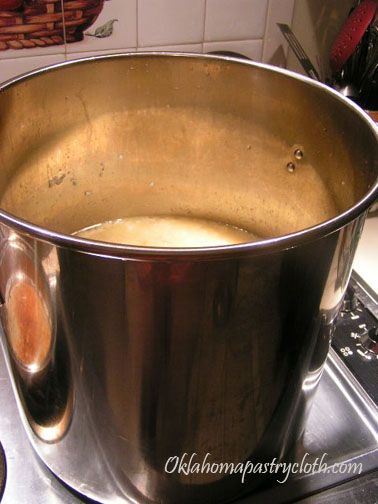 Cut the fat into small pieces. If you have a meat grinder or if the packing house will grind it for you, this works great and makes the fat render so much faster. In a large stock pot, add a quart of water with 2 tbsp. salt. Heat on medium-high to high heat and start adding the fat, a little at a time, stirring as you go. Bring to a boil and cover with a lid, leaving the lid a little off to the side to allow air to vent. If you can’t get all of the fat in at once, just add as the fat starts to melt and leaves more room. 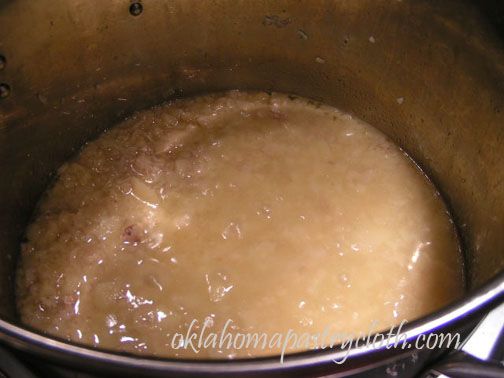 When the fat starts to rise to the surface, lower to the heat so that the mixture is at a low, slow boil, occassionally stirring things around and pressing big pieces to squash them. Cook for at least 4 hours to get plenty of tallow separated. I just let it go and do other things, checking occassionally. I do add a little water if it gets too dry. Be sure that your heat is not too high so that nothing burns or scorches. 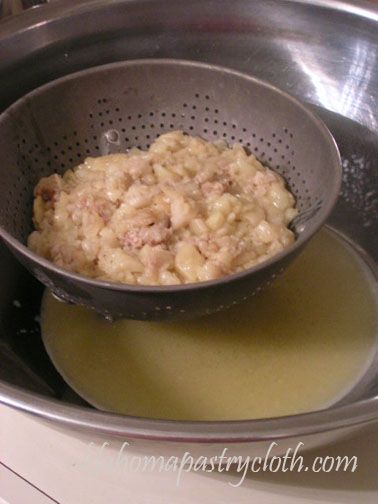 Pour the contents of the pot into a colander in a large bowl or pot or plastic container, a little at a time, to strain. 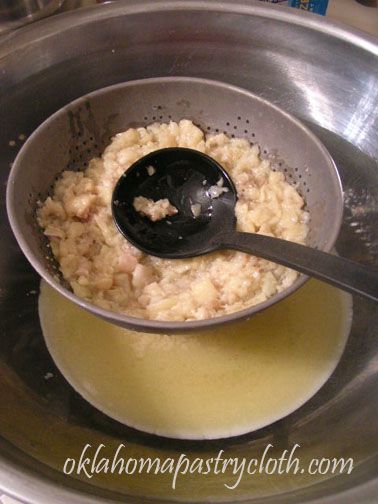 Press the fat in the colander with a spoon to release any extra liquid. Toss the globby fat.  Allow the liquid to come to room temperature. Once cooled, place in the frig covered with plastic wrap or a lid. Refrigerate until the next day. 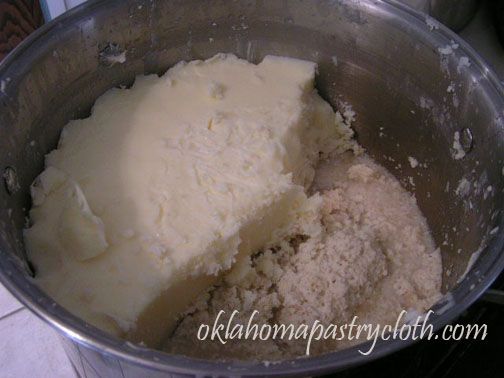 The next day, the mixture will have separated with the tallow at the top, some gray, yucky stuff in the middle and water at the bottom. Lift the solid matter out of its recepticle and throw away the liquid. 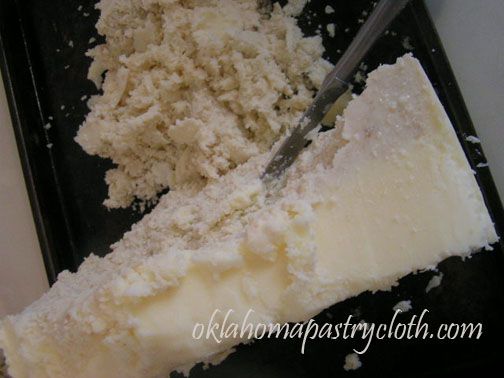 Scrape off the gray matter to separate the pure tallow. 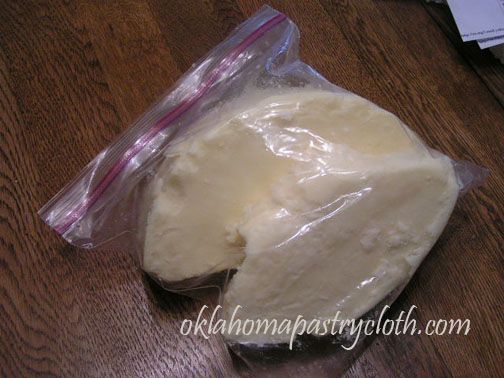 Store the tallow in freezer bags in the refrigerator for up to two months or in the freezer indefinitely. Now you are ready to make soap, candles or anything else that requires tallow! It’s Little House on the Prairie time!! MB |
|
|
|
Tags: fat, instructions, rendering, soap making, tallow

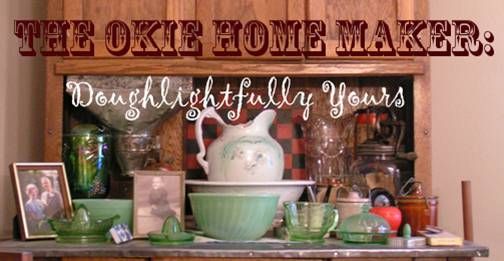
Hal’s aunt used to make her own lye soap. Used it for general washing and cut it into slivers for laundry. She would do demos of making soap outdoors with a big black cauldron. Always made me think of witches brewing something. Really wish I had asked her how she did it, but she’s gone now and all of that knowledge is gone too.
Karen, I’ll be posting step by step how to make the soap and it will most probably be the same way she did it – only on a smaller scale. You can find recipes for just plain lye soap that have no essential oils and then can add whatever oils you want to use. And you can substitute all kinds of oils for part of the tallow or half and half each, etc. Just look up soap recipes and pick which one you want and the process that I will show you will be similar if not the same.
My, my, my… you are certainly a talented lady! My mother would be very proud of you. Even she never tried to do that. And she’s done just about everything else you’ve been talking about at this blog.
(:D) Best regards…
Ha Ha, Hawkeye. My mother never tried it by herself either but she told me about helping her grandmother make soap in a big cast iron pot outside, so I guess it’s in my genes! 🙂
As I’ve mentioned before, I think we’re kindred spirits but now I’m thinking we’re twins!
I’ll see your vw bug story and raise you one. My folks found a car for me to start driving (so my dad could have his 3/4 ton truck back) and sure enough, it too was a ’65 vw bug. Same story as you. Lessons in driving stick ended in tears for me and red face for the folks. Mom swears she said shift and not sh.t. Anyhow, one night after many weeks of me “owning” the bug, I asked to drive the truck to a party. Dad never refused his one and only sweet daughter, except that night. NO! take your car, but dad…No, take your car. Funny how those stick lesson finially kicked in when they needed to. Hummm, do you think our folks knew what they were doing?
I have my grandma’s old betty crocker (1940) cook book with all her added recipes one of which is for lye soap from rendered fat. I was always amazed by that ‘recipe’. And look what you’re doing! How cool is that. Can’t wait to see the end result.
Bye, sis!
hi.
i’ve read that you can use veg oil for soap and that some restaurants will give it to you. is the recipe the same no matter what kind of fat?
the maternal granny of the pegram family in our neighborhood used to appear regularly in their side yard with her black cauldron.her granddaughter, diane, said the soap could take your skin off!!
she was from virginia and wore long skirts like pioneer ladies. i figure she was at least 80 in 1970 so she must have been born in the 1800’s.
i have always wanted to make soap but lacked a cauldron. it is news to me that it can be done indoors. i guess it was made outdoors in the old days because of lye fumes or fire danger??
also, once a year, in autumn, the church ladies made apple butter in a black cauldron. i then discovered from a neighbor, mrs. h. porter, also from virginia!, that she made her apple butter in a big electric roaster in her kitchen. those smart virginians!
looking forward to the rest of your tutorial. then i hope to try it.
i am also one of those who reads a subject to death but by then i’ve scared myself out of the determination to take the leap.
many thanks.
deb harvey
Herdog! I have a new sister!! 🙂 Another to add to the three I grew up with!! Loved your story. Thank you so much for making me laugh.
Deb, I’m thinkin’ that used vegetable oil wouldn’t be very healthy in soap. You can use any veggie oil, but there are a million different recipes with different amounts so look online for a vegetable oil lye soap recipe. And I make apple butter in a big pot on top of the stove every year. If you go to the alphabetical index of posts, you’ll find that recipe and step by step pictures in the list. I hope you will try making the soap! You will get hooked. Next post coming quickly.
[…] Everything But The Moo Three posts ago, I showed you how to render tallow from beef fat for soap making and for old-fashioned candle making as well. The tallow can be used […]